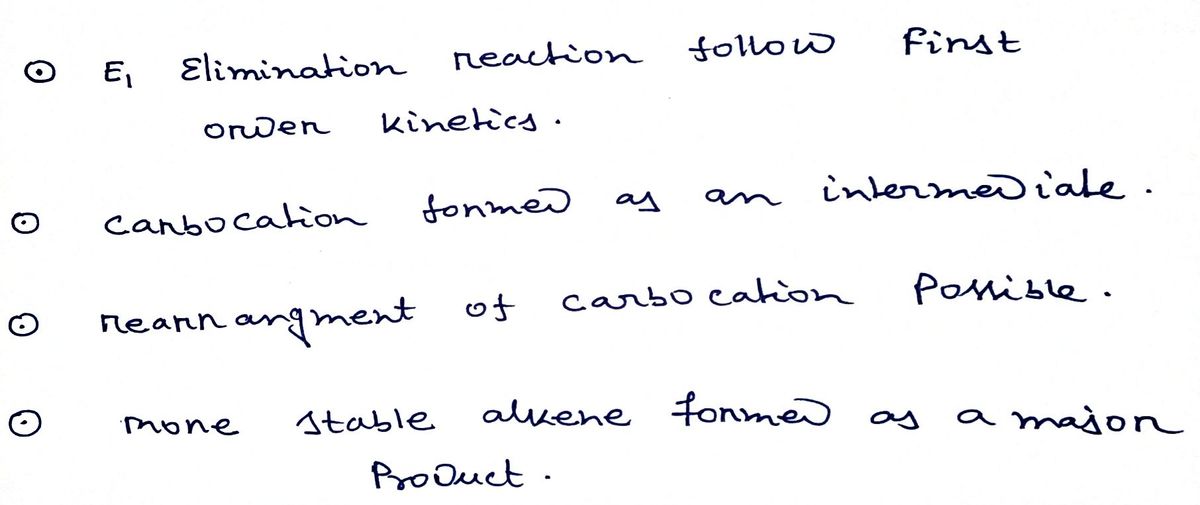Chemistry
10th Edition
ISBN:9781305957404
Author:Steven S. Zumdahl, Susan A. Zumdahl, Donald J. DeCoste
Publisher:Steven S. Zumdahl, Susan A. Zumdahl, Donald J. DeCoste
Chapter1: Chemical Foundations
Section: Chapter Questions
Problem 1RQ: Define and explain the differences between the following terms. a. law and theory b. theory and...
Related questions
Question
Draw all the products in circle the major product of the following E1 reaction. What is the rate expression( rate equation)
![This image depicts a chemical reaction involving an organic compound. The structure on the left portrays a bicyclic compound, specifically a bicyclo[4.1.0]heptane with a chlorine (Cl) substituent attached to one of the bridgehead carbon atoms. Below the chlorine atom, a wedge is used to indicate that the chlorine is above the plane of the carbon ring system.
To the right of the structure is a reaction arrow indicating a chemical transformation. Above the arrow, the reagent ethanol (\( \text{CH}_3\text{CH}_2\text{OH} \)) is specified. Below the arrow, the symbol \(\Delta\) is present, indicating that the reaction is carried out under heating conditions.
This setup suggests a nucleophilic substitution or elimination reaction where the chlorine atom might be replaced or involved in an elimination to form a different product under the influence of ethanol and heat. Such transformations are common in organic chemistry, particularly in synthetic applications.](/v2/_next/image?url=https%3A%2F%2Fcontent.bartleby.com%2Fqna-images%2Fquestion%2Fea03bc01-0c8f-4ac0-bde7-e545ccac1fc8%2Fe56aab07-9db1-48de-87fe-c79a8114d2f2%2Fa954c89_processed.jpeg&w=3840&q=75)
Transcribed Image Text:This image depicts a chemical reaction involving an organic compound. The structure on the left portrays a bicyclic compound, specifically a bicyclo[4.1.0]heptane with a chlorine (Cl) substituent attached to one of the bridgehead carbon atoms. Below the chlorine atom, a wedge is used to indicate that the chlorine is above the plane of the carbon ring system.
To the right of the structure is a reaction arrow indicating a chemical transformation. Above the arrow, the reagent ethanol (\( \text{CH}_3\text{CH}_2\text{OH} \)) is specified. Below the arrow, the symbol \(\Delta\) is present, indicating that the reaction is carried out under heating conditions.
This setup suggests a nucleophilic substitution or elimination reaction where the chlorine atom might be replaced or involved in an elimination to form a different product under the influence of ethanol and heat. Such transformations are common in organic chemistry, particularly in synthetic applications.
Expert Solution
Step 1

Step by step
Solved in 2 steps with 2 images

Knowledge Booster
Learn more about
Need a deep-dive on the concept behind this application? Look no further. Learn more about this topic, chemistry and related others by exploring similar questions and additional content below.Recommended textbooks for you

Chemistry
Chemistry
ISBN:
9781305957404
Author:
Steven S. Zumdahl, Susan A. Zumdahl, Donald J. DeCoste
Publisher:
Cengage Learning

Chemistry
Chemistry
ISBN:
9781259911156
Author:
Raymond Chang Dr., Jason Overby Professor
Publisher:
McGraw-Hill Education

Principles of Instrumental Analysis
Chemistry
ISBN:
9781305577213
Author:
Douglas A. Skoog, F. James Holler, Stanley R. Crouch
Publisher:
Cengage Learning

Chemistry
Chemistry
ISBN:
9781305957404
Author:
Steven S. Zumdahl, Susan A. Zumdahl, Donald J. DeCoste
Publisher:
Cengage Learning

Chemistry
Chemistry
ISBN:
9781259911156
Author:
Raymond Chang Dr., Jason Overby Professor
Publisher:
McGraw-Hill Education

Principles of Instrumental Analysis
Chemistry
ISBN:
9781305577213
Author:
Douglas A. Skoog, F. James Holler, Stanley R. Crouch
Publisher:
Cengage Learning

Organic Chemistry
Chemistry
ISBN:
9780078021558
Author:
Janice Gorzynski Smith Dr.
Publisher:
McGraw-Hill Education

Chemistry: Principles and Reactions
Chemistry
ISBN:
9781305079373
Author:
William L. Masterton, Cecile N. Hurley
Publisher:
Cengage Learning

Elementary Principles of Chemical Processes, Bind…
Chemistry
ISBN:
9781118431221
Author:
Richard M. Felder, Ronald W. Rousseau, Lisa G. Bullard
Publisher:
WILEY